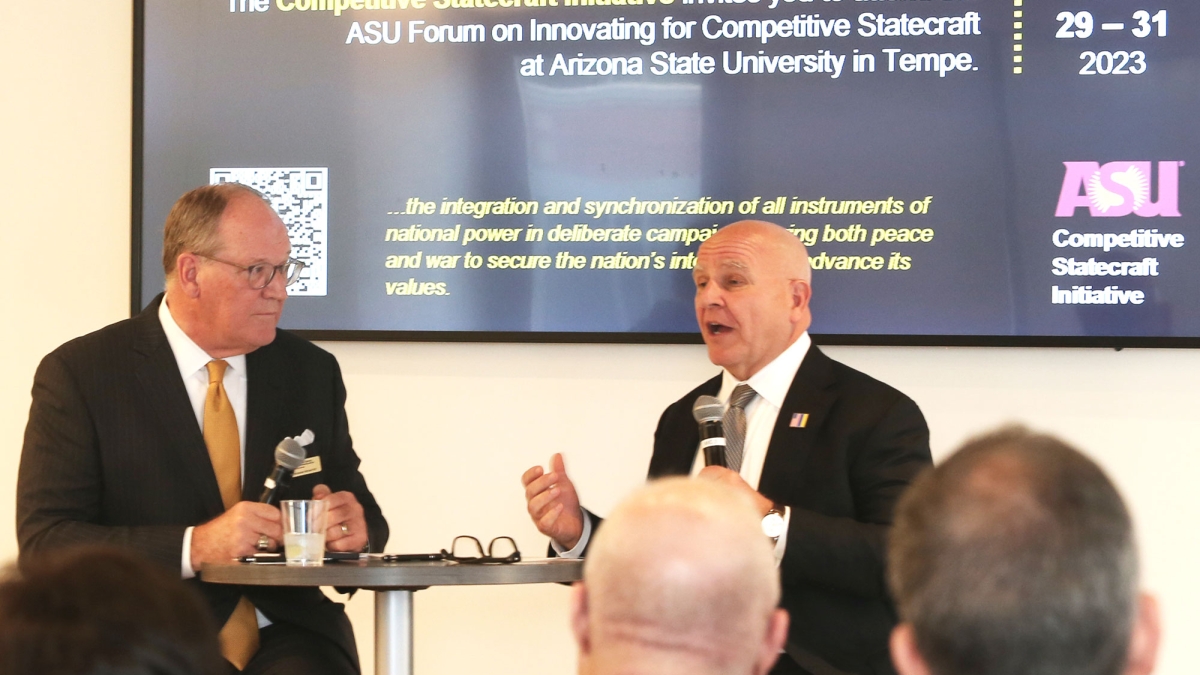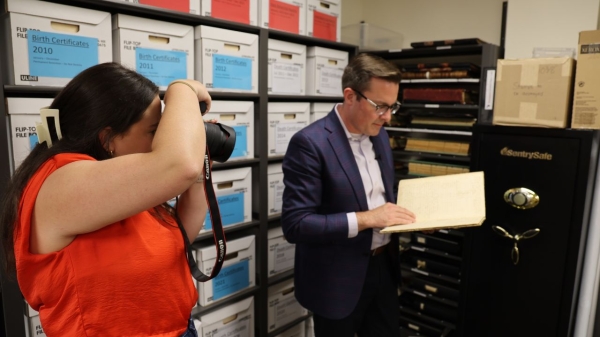The road to innovating competitive statecraft

Lt. Gen. H.R. McMaster expanded on the concept of competitive statecraft during the workshop, which was moderated by Michael C. Polt and served as a precursor to the ASU Forum on Innovating for Competitive Statecraft, being held March 29–31. Photo courtesy ASU
The current strategic imperative for U.S. foreign policy is to develop a competitive statecraft, or the ability to integrate all elements and efforts of like-minded partners. A competitive statecraft would coordinate the advancement of partners’ national interests, overcome obstacles and capitalize on new opportunities as they emerge — in every part of the world.
ASU Distinguished University Fellow and former National Security Advisor Lt. Gen. H.R. McMaster expanded on the concept of competitive statecraft in a workshop hosted by the Arizona State University Competitive Statecraft Initiative at ASU’s Barrett and O’Connor Washington Center in late February. The discussion, moderated by ASU Ambassador-in-Residence Michael C. Polt, served as a precursor to the ASU Forum on Innovating for Competitive Statecraft, being held March 29–31 in Tempe, Arizona.
“I think for so often, too often, especially since the end of the Cold War, we did recognize the continuous interaction with enemies, rivals and adversaries, but it was a linear concept,” said McMaster when explaining his definition of competitive statecraft. “It really was based on the assumption that we would make linear progress toward advancing our security interests, advancing our prosperity, advancing our influence in the world, and that undermines our strategic competence if you don't recognize the competitive nature of foreign policy and national security.”
A key component of competitive statecraft, and a longstanding blind spot in American foreign policy, is strategic empathy, or considering the ideologies, emotions and aspirations of others. A lack of strategic empathy can create foreign policy traps, such as unwarranted optimism and proximity bias. An alternative to competitive statecraft, “leading from behind,” has sometimes created regional voids that American adversaries have exploited for their own purposes.
“You see this with everything in connection with the war in Ukraine, you saw it in Kosovo, in the Balkans in the 1990s. That it really took the United States to do something,” said McMaster. “This vacuum, this perception of us leaving has allowed Russia to portray itself (and) play the role of both arsonists and firemen in the region, and, of course, they're hedging its confrontation with China's long-term investments and arms, procurements and so forth.”
A related problem is chronic American underinvestment in defense. As McMaster pointed out, the U.S. defense budget is much smaller in total compared to the relief checks that were sent to Americans during the COVID-19 pandemic. And the COVID-19 pandemic itself revealed U.S. vulnerabilities in terms of critical supply stockpiles, as well as the country’s industrial and manufacturing base.
McMaster identified three lessons from past U.S. foreign policy mistakes that should be instructive for future decisions:
- Don't under underestimate the amount of time you should take to think about the nature of the challenge you're facing.
- Identify the assumptions on which the planning effort is based, especially assumptions concerning the degree in which you assess like-minded partners who have agency and influence over that challenge.
- The president deserves multiple options to illuminate the disadvantages for the decision-maker, and to ultimately point out the best option.
Despite the significant and complex challenges facing the country, McMaster believes the future is bright.
“I think our confidence is shaken. And I think there has to be a deliberate effort on the part of our leadership, but not even wait for a political class to do this,” McMaster said. “I think we should be Ameri-cans. We’ve had to do this in the past. It's going to take years, but it's gonna take even longer if you don't start now.”
Watch McMaster’s full discussion on innovating for competitive statecraft, organized in collaboration with the ASU Leadership, Diplomacy and National Security Lab.
More Law, journalism and politics

Native Vote works to ensure the right to vote for Arizona's Native Americans
The Navajo Nation is in a remote area of northeastern Arizona, far away from the hustle of urban life. The 27,400-acre…

New report documents Latinos’ critical roles in AI
According to a new report that traces the important role Latinos are playing in the growth of artificial intelligence technology…

ASU's Carnegie-Knight News21 project examines the state of American democracy
In the latest project of Carnegie-Knight News21, a national reporting initiative and fellowship headquartered at Arizona State…